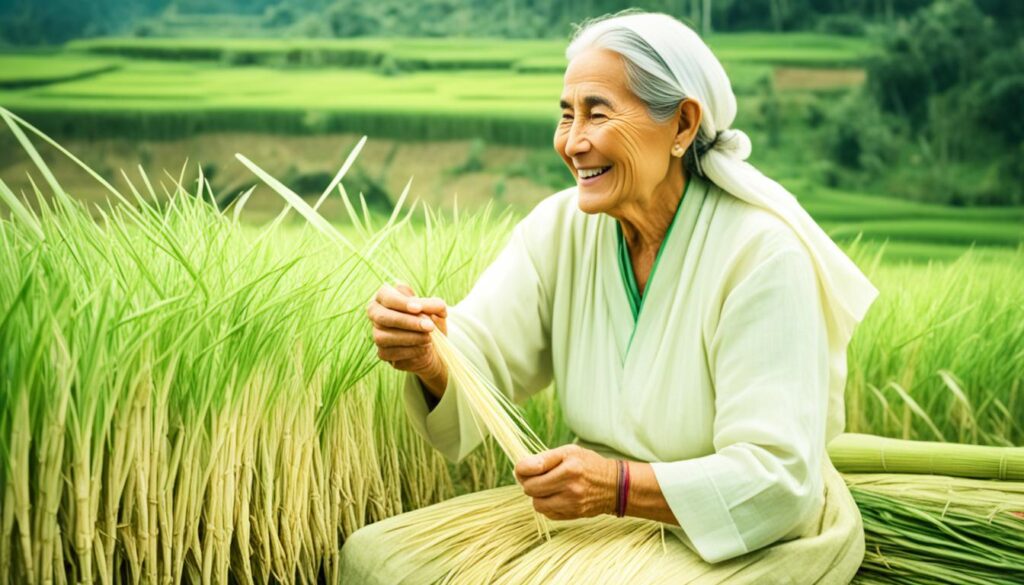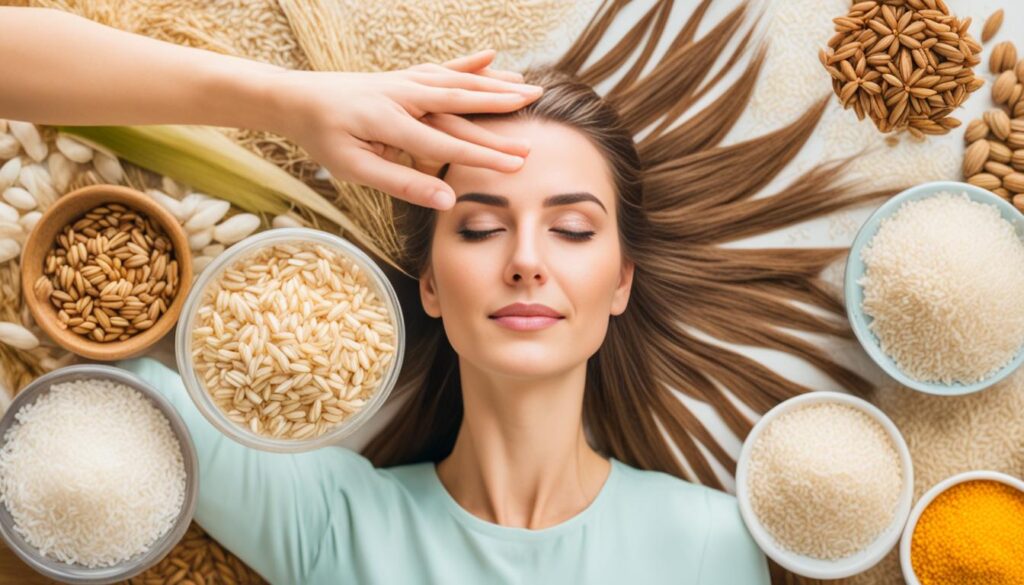
Have you ever wondered why some people choose to braid their hair with rice? It may seem like an unusual practice, but there is a fascinating history and cultural significance behind this tradition. In this article, we will explore the reasons why people braid their hair with rice, the benefits it offers for natural hair care, the cultural significance of rice hair braiding, and how to rice braid your own hair. Get ready to discover the hidden secrets and ancient traditions associated with rice braiding!
- Rice braiding originated during the African slave trade as a means of survival and cultural preservation.
- Rice braiding has cultural significance and is considered a form of natural hair care.
- Rice braiding offers benefits such as promoting hair growth and improving hair health.
- The history of rice braiding is rooted in the African slave trade and has been passed down through generations.
- Learning how to rice braid your hair requires skill and precision.
The Cultural Significance of Rice Hair Braiding
Rice hair braiding holds a deep cultural significance for the Maroon people and other descendants of enslaved Africans. This ancient tradition is much more than just a hairstyle; it is a way for individuals to honor their ancestors and preserve their cultural heritage. Passed down through generations, rice braiding symbolizes resilience, strength, and the ability to adapt and survive.
For the Maroon people, rice hair braiding serves as a powerful reminder of the struggles and contributions of African individuals during the African slave trade. It represents their connection to their African roots and their role in shaping the New World. Through the act of rice braiding, they pay homage to their ancestors and celebrate their cultural identity.
The beauty of rice hair braiding lies not only in its visual appeal but also in the stories and traditions it carries. Each braid tells a tale, reflecting a rich history that spans centuries. The technique of weaving rice seeds into the hair has been meticulously passed down from one generation to another, ensuring that this cultural practice endures.
“Rice braiding is more than just a hairstyle. It is a symbol of our heritage, a connection to our past, and a celebration of our strength.”
– Maroon elder
This artistry of rice hair braiding showcases the ingenuity and resourcefulness of enslaved West Africans during a time of great adversity. By creatively concealing rice seeds within their hair, they were able to transport and cultivate this vital crop in the New World. Rice braiding not only celebrates their survival but also pays tribute to their ability to preserve and adapt cultural practices under challenging circumstances.
Rice Braiding Traditions
Rice braiding traditions vary across different communities and regions but share a common thread of cultural significance. These traditions often involve intricate patterns and designs that require skill and expertise to achieve. The process of rice braiding is a time-honored art form that, when practiced with dedication, can create stunning works of hair craftsmanship.
Throughout history, rice hair braiding has evolved and adapted to reflect the changing times while staying true to its cultural roots. Today, it continues to be cherished and celebrated as a testament to the resilience and legacy of the African diaspora.
History of Rice Hair Braiding
The history of rice hair braiding dates back to the African slave trade, where enslaved West Africans braided rice seeds into their hair as a means of survival and cultural preservation. This tradition enabled them to carry rice seeds with them during the arduous journey across the Atlantic to the Americas.
Once enslaved individuals arrived in the New World, they used the rice seeds concealed in their hair to cultivate the crop in regions such as South Carolina. The cultivation of rice played a crucial role in the economic development of these areas and brought forth the establishment of rice plantations.
Over time, rice hair braiding evolved from a survival tactic to a cherished practice passed down through generations. It has become a symbol of cultural pride and resistance, honoring the enduring legacy of African people and their contributions to the Americas.
| Rice Hair Braiding | Cultural Significance |
|---|---|
| Originated during the African slave trade | Preservation of cultural heritage |
| Symbolizes resilience and strength | Honoring ancestors and struggles |
| Passed down through generations | Connection to African roots |
| Reflects the ability to adapt and survive | Celebration of African contributions |
The Benefits of Rice Braiding for Natural Hair Care
Rice braiding offers several benefits for natural hair care. The process of braiding rice into the hair allows the rice to release nutrients into the hair and scalp.
“Rice braiding can help promote hair growth, strengthen the hair, and improve overall hair health.”
One of the key benefits of rice braiding is the production of rice water. During the braiding process, the rice releases its nourishing properties, which are then captured in the water. Rice water has gained popularity in the natural hair care community due to its ability to moisturize and condition the hair.
Rice water has been found to contain vitamins, minerals, and antioxidants that benefit the hair and scalp. Some of its main benefits include:
- Promoting hair growth: The nutrients present in rice water can stimulate the hair follicles and promote healthy hair growth.
- Strengthening the hair: The amino acids in rice water can help strengthen the hair strands, reducing breakage and improving overall hair strength.
- Improving hair health: Rice water can restore the pH balance of the scalp and hair, helping to maintain a healthy scalp environment. It also adds shine to the hair and can reduce frizz.
In addition to rice water, rice hair treatments have also become popular in natural hair care routines. These treatments can include rice oil, rice milk, or rice extract, which are infused into hair products or used directly on the hair. Rice hair treatments provide moisturizing, nourishing, and conditioning benefits, leaving the hair soft, smooth, and healthy.
Overall, incorporating rice braiding and rice hair treatments into your natural hair care routine can help improve the condition of your hair, promote growth, and enhance its overall health.
Take a look at the table below for a summary of the benefits of rice braiding for natural hair care:
| Benefits of Rice Braiding for Natural Hair Care |
|---|
| Promotes hair growth |
| Strengthens the hair |
| Improves hair health |
| Moisturizes and conditions the hair |
| Reduces breakage and frizz |
| Restores shine to the hair |

The History and Origins of Rice Hair Braiding
The history of rice hair braiding dates back to the African slave trade, where enslaved West African women utilized this technique as a means of survival and cultural preservation. By braiding rice seeds into their hair, they were able to transport this essential crop from their homeland to the Americas, particularly regions like South Carolina.
The practice of rice braiding played a crucial role in the cultivation of rice in the New World, as these seeds served as a precious resource that contributed to the establishment of rice plantations. It was a way for enslaved Africans to ensure a future food supply and maintain a connection to their cultural roots.
“Rice hair braiding was not only a practical method of seed transportation, but it also carried deep cultural significance. It allowed enslaved Africans to protect their cultural heritage and pass down traditions through generations, even in the face of unimaginable hardships.”
Over time, rice hair braiding evolved from a survival technique to a symbol of resilience, strength, and adaptation. It became a cherished cultural practice that represented the struggles and contributions of African people during the African slave trade and their lasting influence on the New World.

How to Rice Braid Hair
Rice braiding is a unique and intricate technique that requires skill and practice. To rice braid hair, rice seeds are carefully placed along the scalp and then concealed within the braids. The braids are created in a specific pattern to ensure that the rice seeds remain securely in place. The process requires attention to detail and precision to achieve the desired result. While there are variations in the technique, the basic concept of rice braiding involves hiding the rice seeds within the braids.
If you’re interested in learning how to rice braid your hair, follow these simple steps:
- Start by sectioning your hair into smaller, manageable parts. This will make the braiding process easier and ensure that the rice seeds are evenly distributed.
- Take a small handful of rice seeds and place them along the roots of the hair in the chosen section.
- Using your fingers or a comb, create a three-strand braid, incorporating the rice seeds as you go along. Make sure the braid is tight and secure to prevent the rice seeds from falling out.
- Continue braiding until you reach the ends of the hair, making sure to hide the rice seeds within the braid.
- Repeat these steps for each section of hair until your entire head is rice braided.
- To finish the style, you can secure the ends of the braids with hair ties or decorative beads.
Remember, practice makes perfect when it comes to rice braiding. It may take some time to master the technique, but with patience and perseverance, you’ll be able to create beautiful rice braided hairstyles.

Conclusion
Rice braiding is an ancient cultural tradition that holds immense importance and significance. It serves as a powerful testament to the ingenuity and resilience of enslaved West Africans, who used it as a means of preserving their roots during the dark times of the African slave trade. By braiding rice seeds into their hair, they not only carried a vital source of sustenance but also symbolized their connection to their African heritage.
In addition to its rich cultural history, rice braiding also offers numerous benefits for natural hair care. The use of rice water and rice hair treatments has been proven to promote healthy hair growth, strengthen the strands, and enhance overall hair health. The nutrients released by the rice during the braiding process provide nourishment to the hair and scalp, resulting in lustrous and vibrant tresses.
Today, the history and tradition of rice braiding continue to be cherished and celebrated by communities worldwide. It serves as a reminder of the resilience and strength of African people, as well as a way to honor and preserve their cultural heritage. As we embrace the beauty of diversity and cultural traditions, rice braiding stands as a shining example of the importance of embracing and celebrating our roots.






